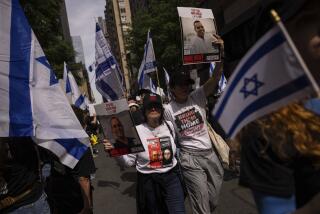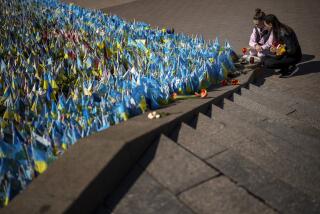Soviets Show Off SS-21 Missiles and Honor Veterans on V-E Day
- Share via
MOSCOW — The Soviet Union showed off its SS-21 nuclear missiles for the first time Thursday in a Red Square parade of military might to mark the 40th anniversary of the end of World War II in Europe.
Despite the military display, Soviet leader Mikhail S. Gorbachev took the occasion to say that the Kremlin will rely on “a patient and constructive dialogue” to deal with troubling world problems.
U.S. Ambassador Arthur A. Hartman boycotted the parade to protest the killing of an American Army major by a Soviet sentry in East Germany last March 24. But Hartman said he and Gorbachev, speaking briefly at a Kremlin reception, both expressed hopes for positive results from a meeting next week in Vienna between Secretary of State George P. Shultz and Foreign Minister Andrei A. Gromyko.
The Soviet Union and its allies mark V-E Day on May 9, when Soviet troops captured their last city--Prague--and Josef Stalin announced the news of the war’s end to the Soviet people. The West observes the anniversary one day earlier.
Honoring Veterans
Festivities were held Thursday throughout the Soviet Union to honor the dwindling number of veterans from the Great Patriotic War, as the Soviets call it, and to celebrate the victory over Nazi Germany in 1945.
In Moscow’s Gorky Park, bemedaled old soldiers held impromptu reunions, danced and sang wartime melodies in an outpouring of nostalgia and high spirits that recalled the American observance of the U.S. bicentennial year in 1976.
“Friendship!” a white-haired army veteran told two Americans who congratulated him on the holiday.
Earlier, in Red Square, an army general said the war’s end benefited not only the Soviet people but the whole world, adding, “It brought us 40 years of peace.”
The parade, a blend of tanks and troops that fought in World War II mixed with modern missiles and young active-duty soldiers, was reviewed by Gorbachev and other Soviet leaders from atop Lenin’s Tomb.
The SS-21 missiles, tactical weapons with a range of about 75 miles, rolled by on six-wheeled carriages. Some of them are known to be deployed in East Germany and are aimed at Western Europe.
Cloud of Black Smoke
They followed a squadron of T-34 tanks, four decades old, that rumbled across the cobblestones in a cloud of black smoke. Troops in World War II uniforms followed, along with the legendary Katyusha rockets used against the Nazi invaders.
Among those marching were some Soviet veterans who had marched in the original victory parade on June 24, 1945. Soviet partisan fighters also marched, as did units of Polish and Czechoslavak troops and the goose-stepping Soviet soldiers, sailors and airmen from the Moscow garrison.
Ambassadors from most North Atlantic Treaty Organization countries attended, temporarily shelving a boycott of military parades in effect since the Soviet intervention in Afghanistan in 1979.
West Germany, which was invited, declined to send a representative, although its ambassador Wednesday laid a wreath honoring Soviet war dead.
When Gorbachev spoke at a reception after the parade, he used none of the harsh anti-American rhetoric he had employed Wednesday in a speech at a Kremlin meeting. “The present-day world is complicated and unquiet,” he said Thursday, “and there is no task more important today than . . . checking the slide into a nuclear abyss.
“Regardless of how acute and complex the problems of present-day world politics are, they can and must be resolved only by way of talks, a patient and constructive dialogue,” he added. “It is this that our (Communist) party and our Soviet state are following and will continue to follow.”
Meantime, a senior Western diplomat said that while Gorbachev’s speech Wednesday contained some anti-American barbs, it was intended primarily for domestic consumption. The aim, the diplomat said, was to encourage a spirit of wartime sacrifice and discipline in dealing with the Soviet Union’s pressing domestic and social problems.
“I think we are going to move slowly in terms of progress on international issues,” added the diplomat, who asked not to be identified so he could speak more frankly.
Tribute to Allies
At the parade, Defense Minister Sergei L. Sokolov paid tribute to the United States and other wartime allies for their contribution to victory over Germany. But he also expressed the Soviet view that Adolf Hitler acted with the encouragement of “imperialist” nations, which usually refers to the United States and its Western allies.
“The routing of the crack forces of imperialism (Nazi Germany) led to the weakening of its positions and to the aggravation and deepening of the general crisis of capitalism,” Sokolov said.
It was this view of World War II--that it was a triumph of the Soviet system over capitalism--that made it difficult for Western governments to join in the 40th anniversary celebrations, one Western diplomat said.
The 54-year-old Gorbachev, who was a farm boy of 14 at the end of the war, was greeted with loud applause as he paused and waved to spectators before he led members of the ruling Politburo to their places on Lenin’s Tomb.
Huge Band Assembled
An artillery salute was fired while a huge massed band--including 28 tubas and 10 glockenspiels--played the Soviet national anthem.
The war, which is said to have directly affected nearly every family in the Soviet Union, is at once a source of sorrow and great national pride. Veterans, their medals often covering most of the front of their suit jackets, were treated with great respect Thursday.
In Gorky Park, a young girl rushed up to an old soldier, kissed him and handed him a bouquet of tulips. It was a scene often repeated there and in front of the Bolshoi Theater, another center of celebration.
Tass, the official news agency, explained why the war has such a haunting presence so long after it ended. “The war took a toll of 20 million Soviet lives,” Tass said. “If the memory of each of them was honored with a minute of silence, the silence would last for nearly 40 years.”
Parade in Warsaw
Thursday in Poland, where World War II began with a German invasion on Sept. 1, 1939, and a Soviet invasion 16 days later, the 40th anniversary of the war’s end was marked by artillery salutes, the wailing of air-raid sirens and a military parade in Warsaw.
Twenty-four-gun salutes were fired shortly before noon in Warsaw and eight other Polish cities. Sirens sounded in the capital at noon for one minute and traffic halted on major streets.
An article in the Communist Party newspaper Trybuna Ludu claimed that the United States, Britain and France share equal blame with Nazi Germany for the outbreak of the war and that the Soviet Union was responsible for Germany’s defeat.
‘Revolting’ Distortion
One Western diplomat called the prominently displayed article a “revolting” distortion of history and noted that Britain and France had in fact entered the war in defense of Poland.
But despite the anti-Western polemics in the official press, ranking envoys from the United States and other Western members of the wartime alliance laid memorial wreaths at the tomb of Poland’s unknown soldier and watched a military parade of about 3,000 Polish troops in the center of Warsaw. The United States, which has no ambassador in Poland, was represented by Charge d’Affaires John Davis.
In a pointed snub of Poland’s former Western allies, the official PAP news agency reported only that wreaths were laid by representatives of Communist countries, including the Soviet Union, Cuba and Mongolia, and by “other foreign delegations.”
Times staff writer Robert Gillette, in Warsaw, contributed to this story.
More to Read
Sign up for Essential California
The most important California stories and recommendations in your inbox every morning.
You may occasionally receive promotional content from the Los Angeles Times.










